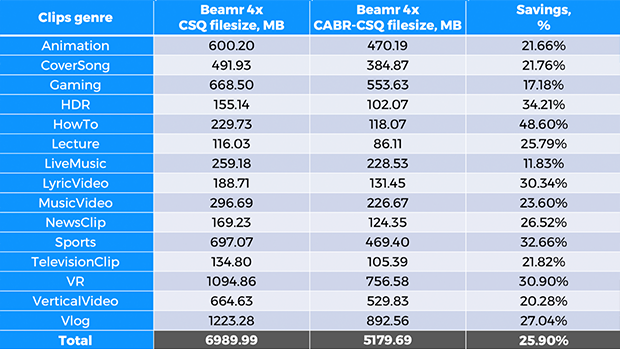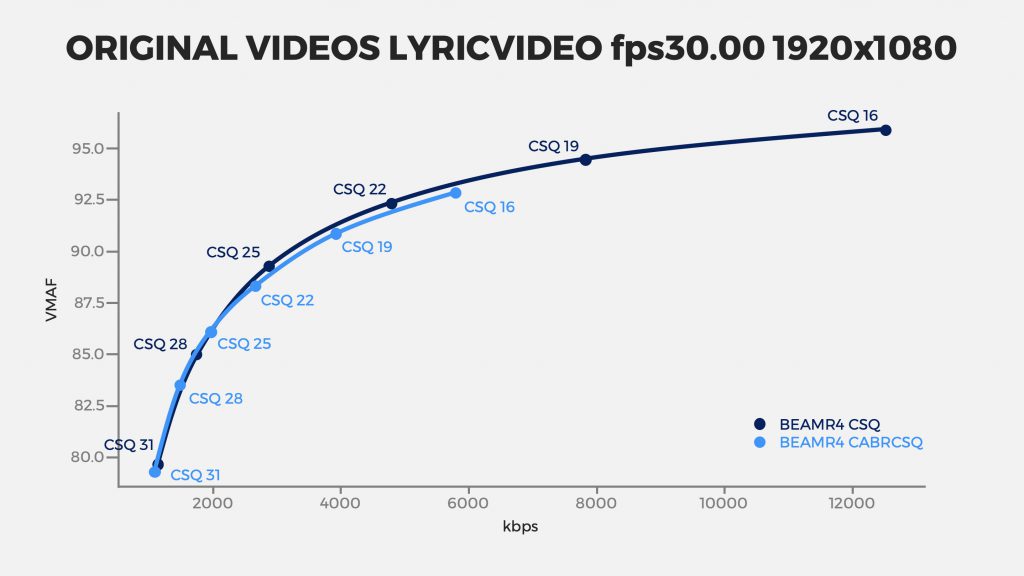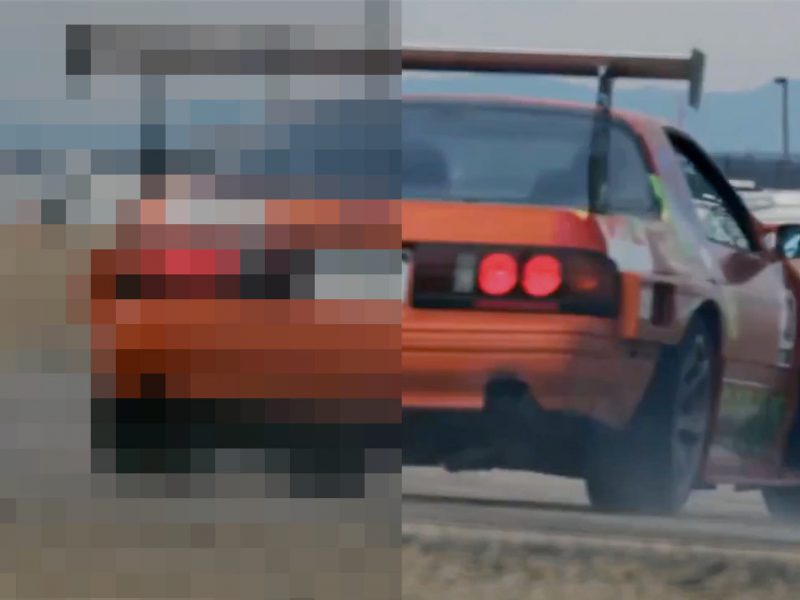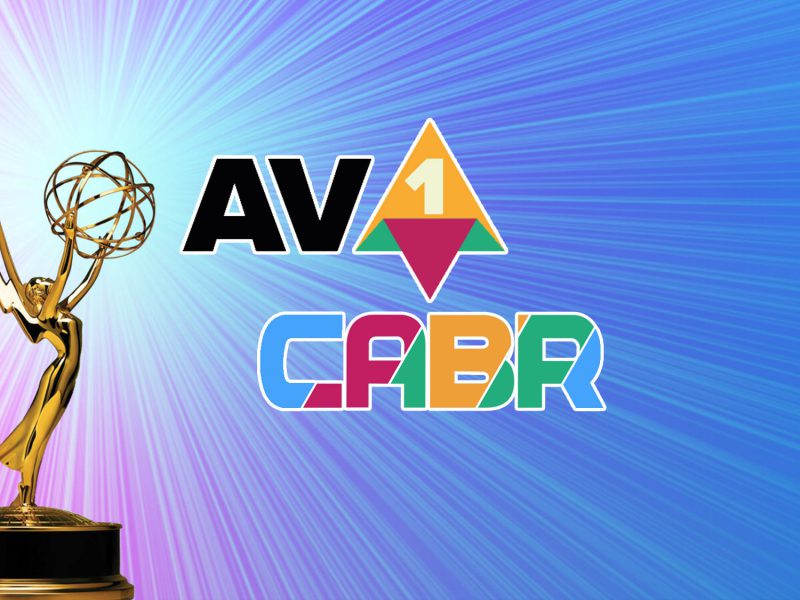Introduction
The attention of Internet users, especially the younger generation, is shifting from professionally-produced entertainment content to user-generated videos and live streams on YouTube, Facebook, Instagram and most recently TikTok. On YouTube, creators upload 500 hours of video every minute, and users watch 1 billion hours of video every day. Storing and delivering this vast amount of content creates significant challenges to operators of user-generated content services. Beamr’s CABR (Content Adaptive BitRate) technology reduces video bitrates by up to 50% compared to regular encodes, while preserving perceptual quality and creating fully-compliant standard video streams that don’t require any proprietary decoder on the playback side. CABR technology can be applied to any existing or future block-based video codec, including AVC, HEVC, VP9, AV1, EVC and VVC.
In this blog post we present the results of a UGC encoding test, where we selected a sample database of videos from YouTube’s UGC dataset, and encoded them both with regular encoding and with CABR technology applied. We compare the bitrates, subjective and objective quality of the encoded streams, and demonstrate the benefits of applying CABR-based encoding to user-generated content.
Beamr CABR Technology
At the heart of Beamr’s CABR (Content-Adaptive BitRate) technology is a patented perceptual quality measure, developed during 10 years of intensive research, which features very high correlation with human (subjective) quality assessment. This correlation has been proven in user testing according to the strict requirements of the ITU BT.500 standard for image quality testing. For more information on Beamr’s quality measure, see our quality measure blog post.
When encoding a frame, Beamr’s encoder first applies a regular rate control mechanism to determine the compression level, which results in an initial encoded frame. Then, the Beamr encoder creates additional candidate encoded frames, each one with a different level of compression, and compares each candidate to the initial encoded frame using the Beamr perceptual quality measure. The candidate frame which has the lowest bitrate, but still meets the quality criteria of being perceptually identical to the initial frame, is selected and written to the output stream.
This process repeats for each video frame, thus ensuring that each frame is encoded to the lowest bitrate, while fully retaining the subjective quality of the target encode. Beamr’s CABR technology results in video streams that are up to 50% lower in bitrate than regular encodes, while retaining the same quality as the full bitrate encodes. The amount of CPU cycles required to produce the CABR encodes is only 20% higher than regular encodes, and the resulting streams are identical to regular encodes in every way except their lower bitrate. CABR technology can also be implemented in silicon for high-volume video encoding use cases such as UGC video clips, live surveillance cameras etc.
For more information about Beamr’s CABR technology, see our CABR Deep Dive blog post.
CABR for UGC
Beamr’s CABR technology is especially suited for User-Generated Content (UGC), due to the high diversity and variability of such content. UGC content is captured on different types of devices, ranging from low-end cellular phones to high-end professional cameras and editing software. The content itself varies from “talking head” selfie videos, to instructional videos shot in a home or classroom, to sporting events and even rock band performances with extreme lighting effects.
Encoding UGC content with a fixed bitrate means that such a bitrate might be too low for “difficult” content, resulting in degraded quality, while it may be too high for “easy” content, resulting in wasted bandwidth. Therefore, content-adaptive encoding is required to ensure that the optimal bitrate is applied to each UGC video clip.
Some UGC services use the Constant Rate Factor (CRF) rate control mode of the open-source x264 video encoder for processing UGC content, in order to ensure a constant quality level while varying the actual bitrate according to the content. However, CRF bases its compression level decisions on heuristics of the input stream, and not on a true perceptual quality measure that compares candidate encodes of a frame. Therefore, even CRF encodes waste bits that are unnecessary for a good viewing experience. Beamr’s CABR technology, which is content-adaptive at the frame level, is perfectly suited to remove these remaining redundancies, and create encodes that are smaller than CRF-based encodes but have the same perceptual quality.
Evaluation Methodology
To evaluate the results of Beamr’s CABR algorithm on UGC content, we used samples from the YouTube UGC Dataset. This is a set of user-generated videos uploaded to YouTube, and distributed under the Creative Commons license, which was created to assist in video compression and quality assessment research. The dataset includes around 1500 source video clips (raw video), with a duration of 20 seconds each. The resolution of the clips ranges from 360p to 4K, and they are divided into 15 different categories such as animation, gaming, how-to, music videos, news, sports, etc.
To create the database used for our evaluation, we randomly selected one clip in each resolution from each category, resulting in a total of 67 different clips (note that not all categories in the YouTube UGC set have clips in all resolutions). The list of the selected source clips, including links to download them from the YouTube UGC Dataset website, can be found at the end of this post. As typical user-generated videos, many of the videos suffer from perceptual quality issues in the source, such as blockiness, banding, blurriness, noise, jerky camera movements, etc. which makes them specifically difficult to encode using standard video compression techniques.
We encoded the selected video clips using Beamr 4x, Beamr’s H.264 software encoder library, version 5.4. The videos were encoded using speed 3, which is typically used to encode VoD files in high quality. Two rate control modes were used for encoding: The first is CSQ mode, which is similar to x264 CRF mode – this mode aims to provide a Constant Subjective Quality level, and varies the encoded bitrate based on the content to reach that quality level. The second is CSQ-CABR mode, which creates an initial (reference) encode in CSQ mode, and then applies Beamr’s CABR technology to create a reduced-bitrate encode which has the same perceptual quality as the target CSQ encode. In both cases, we used a range of six CSQ values equally spaced from 16 to 31, representing a wide range of subjective video qualities.
After we completed the encodes in both rate control modes, we compared three attributes of the CSQ encodes to the CSQ-CABR encodes:
- File Size – to determine the amount of bitrate savings achievable by the CABR-CSQ rate control mode
- BD-Rate – to determine how the two rate control modes compare in terms of the objective quality measures PSNR, SSIM and VMAF, computed between each encode and the source (uncompressed) video
- Subjective quality – to determine whether the CSQ encode and the CABR-CSQ encode are perceptually identical to each other when viewed side by side in motion.
Results
The table below shows the bitrate savings of CABR-CSQ vs. CSQ for various values of the CSQ parameter. As expected, the savings are higher for low CSQ values, which correlate with higher subjective quality and higher bitrates. As the CSQ increases, quality decreases, bitrate decreases, and the savings of the CABR-CSQ algorithm are decreased as well.

The overall average savings across all clips and all CSQ values is close to 26%. If we average the savings only for the high CSQ values (16-22), which correspond to high quality levels, the average savings are close to 32%. Obviously, saving one quarter or one third of the storage cost, and moreover the CDN delivery cost, can be very significant for UGC service providers.
Another interesting analysis would be to look at how the savings are distributed across specific UGC genres. Table 2 shows the average savings for each of the 15 content categories available on the YouTube UGC Dataset.

As we can see, simple content such as lyric videos and “how to” videos (where the camera is typically fixed) get relatively higher savings, while more complex content such as gaming (which has a lot of detail) and live music (with many lights, flashes and motion) get lower savings. However, it should be noted that due to the relatively low number of selected clips from each genre (one in each resolution, for a total of 2-5 clips per genre), we cannot draw any firm conclusions from the above table regarding the expected savings for each genre.
Next, we compared the objective quality metrics PSNR, SSIM and VMAF for the CSQ encodes and the CABR-CSQ encodes, by creating a BD-Rate graph for each clip. To create the graph, we computed each metric between the encodes at each CSQ value and the source files, resulting in 6 points for CSQ and 6 points for CABR-CSQ (corresponding to the 6 CSQ values used in both encodes). Below is an example of the VMAF BD-Rate graph comparing CSQ with CABR-CSQ for one of clips in the lyric video category.

As we can see, the BD-Rate curve of the CABR-CSQ graph follows the CSQ curve, but each CSQ point on the original graph is moved down and to the left. If we compare, for example, the CSQ 19 point to the CABR-CSQ 19 point, we find that CSQ 19 has a bitrate of around 8 Mbps and a VMAF score of 95, while the CABR-CSQ 19 point has a bitrate of around 4 Mbps, and a VMAF score of 91. However, when both of these files are played side-by-side, we can see that they are perceptually identical to each other (see screenshot from the Beamr View side by side player below). Therefore, the CABR-CSQ 19 encode can be used as a lower-bitrate proxy for the CSQ 19 encode.

Finally, to verify that the CSQ and CABR-CSQ encodes are indeed perceptually identical, we performed subjective quality testing using the Beamr VISTA application. Beamr VISTA enables visually comparing pairs of video sequences played synchronously side by side, with a user interface for indicating the relative subjective quality of the two video sequences (for more information on Beamr VISTA, listen to episode 34 of The Video Insiders podcast). The set of target comparison pairs comprised 78 pairs of 10 second segments of Beamr4x CSQ encodes vs. corresponding Beamr4x CABR-CSQ encodes. 30 test rounds were performed, resulting in 464 valid target pair views (e.g. by users who correctly recognized mildly distorted control pairs), or on average 6 views per pair. The results show that on average, close to 50% of the users selected CABR-CSQ as having lower quality, while a similar percentage of users selected CSQ as having lower quality, therefore we can conclude that the two encodes are perceptually identical with a statistical significance exceeding 95%.

Conclusions
In this blog post we presented the results of applying Beamr’s Content Adaptive BitRate (CABR) encoding to a random selection of user-generated clips taken from the YouTube UGC Dataset, across a range of quality (CSQ) values. The CABR encodes had 25% lower bitrate on average than regular encodes, and at high quality values, 32% lower bitrate on average. The Rate-Distortion graph is unaffected by applying CABR technology, and the subjective quality of the CABR encodes is the same as the subjective quality of the regular encodes. By shaving off a quarter of the video bitrate, significant storage and delivery cost savings can be achieved, and the strain on today’s bandwidth-constrained networks can be relieved, for the benefit of all netizens.
Appendix
Below are links to all the source clips used in the Beamr 4x CABR UGC test.
Animation: Animation 360p Animation 480p Animation 720p Animation 1080p Animation 2160p
CoverSong: CoverSong 360p CoverSong 480p CoverSong 720p CoverSong 1080p
Gaming: Gaming 360p Gaming 480p Gaming 720p Gaming 1080p Gaming 2160p
HowTo: HowTo 360p HowTo 480p HowTo 720p HowTo 1080p
Lecture: Lecture 360p Lecture 480p Lecture 720p Lecture 1080p
LiveMusic: LiveMusic 360p LiveMusic 480p LiveMusic 720p LiveMusic 1080p
LyricVideo: LyricVideo 360p LyricVideo 480p LyricVideo 720p LyricVideo 1080p
MusicVideo: MusicVideo 360p MusicVideo 480p MusicVideo 720p MusicVideo 1080p
NewsClip: NewsClip 360p NewsClip 480p NewsClip 720p NewsClip 1080p
Sports: Sports 360p Sports 480p Sports 720p Sports 1080p
TelevisionClip: TelevisionClip 360p TelevisionClip 480p TelevisionClip 720p TelevisionClip 1080p
VerticalVideo: VerticalVideo 360p VerticalVideo 480p VerticalVideo 720p VerticalVideo 1080p VerticalVideo 2160p
Vlog: Vlog 360p Vlog 480p Vlog 720p Vlog 1080p Vlog 2160p

